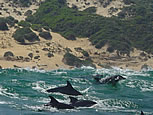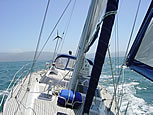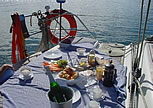![]()
Whale Migration South Africa

Vacationtechnician personalized luxury adventure travel transports you to the most exquisite wilderness and chill out retreats on Earth. Conserving rare biodiversity through low volume tourism; our aim is your indulgence -at no one's expense. Plan now to be assured a rejuvenating escape at a restful pace -to an unspoilt gem in the purest sense.
At the southern tip of Africa, where two of the world's greatest oceans converge, a total experience of land, sea and the rainbow culture of the Western Cape offer you the most exciting land based whale watching venues in the world!
Each year Southern Right whales migrate into the coastal waters of the Western Cape to calve and nurse their young. The animals, often mere metres from the shore, provide unsurpassed whale watching opportunities between June and November. Humpbacks migrate through the region between May and December each year, while Bryde's whales are found slightly further offshore all year round.
The Whale Route starts along the south of Cape Town and extends to Durban, 1,200 plus miles of whale watching coastline. The route traverses several famous protected areas, including the Garden Route, Tsitsikamma National Park, and the Transkei.
At least 37 species of whales and dolphins can be found in the waters off South Africa.
However, the Route is most famous for encounters with southern right whales, humpback whales, and several coastal dolphin species. You can also see African penguins, Cape fur seals, black oystercatcher birds and a variety of other marine life.
The Cape Whale Route stretches for 900 km from Doringbaai on the West Coast to Storms River Mouth in the Tsitsikamma National Park.
Places from which to observe these gentle giants include Lamberts Bay on the Cape West Coast, down to Elandsbaai and Saldanha Bay, down to Yzerfontein and Cape Town, around the Peninsula and into False Bay, where whales frolick in the protected waters, on to Bettys Bay and Hermanus, where the Whale Cryer informs on whale sightings and where whales come into the old harbour to calve, then all along the coast to Gansbaai, further down to Cape Agulhas, Struisbaai and Arniston, where whales come into the protected waters, down to De Hoop Nature and Marine Reserve and Witsand, at the mouth of the Breede River, Still Bay - where the Southern Rights enter the placid water to bear their calves, Gouritzmond, Vleesbaai, Dana Bay, Mossel Bay - especially on the St Blaize's hiking trail, Hartenbos, Great Brak River, Ballot's Bay, Herold's Bay, Victoria Bay, Wilderness - especially from Dolphin's Point on the Kaaiman's Pass, Sedgefield, Knysna - especially from Brenton-on-Sea and Knysna Heads, and Plettenberg Bay, which offers a "whale hotline" and where whales often come in close, especially at Keurbooms River and beaches, as well as Robberg Peninsula.
In season, from June to November, the 65 km Whale Route along the greater Mossel Bay coastline is superbly suited to view whales. Four species are seen along this route, of which Southern Right Whales are the most commonly sighted when they come into Mossel Bay to calve. There are however also Humpback, Bryde's and Killer Whales frequenting the route. Mossel Bay also forms part of Four species of whales frequent Mossel Bay to calve.
Informative whale interpretation boards situated at beautiful view points makes it the ideal route to view these giant mammals of the ocean.
Experience the thrill of viewing the giants of the deep close up, by taking a 3-hour boat based whale-watching trip.
Schools of up to 500 dolphins make a spectacular sight and can often be seen at play in the bay and along the St Blaize hiking trail. The most common dolphins found all year are Heaviside's Dolphin, Common Dolphin, Dusky Dolphin and Bottlenose Dolphin.
The Southern Right whale migrates from Antarctica to calve in the sheltered bays of the east coast of southern Africa. From July to November, Walker Bay - about 90 minutes drive east of Cape Town - is one of the world's most spectacular vantage points for whale-watching. Whales breach, lobtail and engage in courtship rituals - often as close as 50 metres from the shore.
Behaviours
Whales tend to show of in the following manner:
Blowing: A sound made when expelling air through the blowhole. This is accompanied by a spout of condensed water vapour. This however is the normal breathing pattern of the animal.
Breaching: Leaping out of water in an arching back flip and falling back on their sides or back with a resounding slap. This is believed to be a way of communication, exercise or possibly to scratch the parasites off that live on whales. They can braech form 3 to 8 times in succesion.
Lobtailing: The slapping of flukes and tail on the water, causing a loud sound, appears to be a means of communication.
Spy hopping: The head and body are lifted vertically, as far as the flippers, above the surface. This enables them to see what is happening around them above water.
There are estimated to be about 3 000 - 4 000 southern right whales at present, with South Africa receiving the major percentage visiting its coasts annually. Present populations of southern right whales are a fraction of estimated initial stocks.
The southern right whale has a circumpolar distribution and inhabits sub Antarctic water between about 30° and 55° south. The whales migrate south during the summer months when supplies of krill are more prolific, and north during winter and spring to mate, calve and rear their young. They appear around the South African coastline from May to December. They can be seen interacting in the sheltered bays and coves close inshore and near river mouths.
Southern Right whales migrate into the extreme coastal waters off the Western Cape each year to calve, nurse their young and mate.
The humpback whales are seen as they migrate along our coast between May and November en-route to their feeding and breeding grounds off Mozambique and Angola.
Bryde's whales are found further offshore in False Bay all year round, and the orca ("killer" whale) is also occasionally seen. Heaviside's and dusky dolphins are found in the colder waters on the western side of the Peninsula, and bottlenose, common and humpback dolphins on the eastern (False Bay) side.
It is illegal to approach within 300 m of whales by boat, kayak, ski-boat, aircraft or any other means without a permit. Boat-based whale watching has recently become legal in South Africa, but only for the few operators that have been issued boat based whale watching permits.
The southern right makes use of extreme coastal waters along the southern and south-eastern coastal region of the Cape, and sometimes as far north as southern KwaZulu-Natal. The KwaZulu Natal whale season starts on July 1 and continues until November.
Boat-based whale-watching, previously only associated with the Western Cape, is gaining momentum in the province with a greater variety of species being spotted off the KwaZulu Natal coast. Seeing whales off the coast of KwaZulu Natal is virtually guaranteed.
South Africa retains its position as the fifth fastest growing whale- watching destination in the world. Only 16 permits have been issued countrywide to ensure regulation of the industry and minimum intrusion on the whales who come to the warmer waters of the south to mate.
When to go: July to November
Viewing options: Shoreline, boat
SCIENTIFIC NAMES OF WHALE AND DOLPHIN SPECIES MENTIONED IN THE TEXT
Southern right whale Eubalaena australis
Humpback whale Megaptera novaeangliae
Bryde's whale Balaenoptera edeni
Orca (killer whale) Orcinus orca
Short-beaked common dolphin Delphinus delphis
Long-beaked common dolphin Delphinus capensis
Dusky dolphin Lagenorhynchus obscurus
Heaviside's dolphin Cephalorhynchus heavisidii
Bottlenose dolphin Tursiops truncatus
Indo-Pacific humpbacked dolphin Sousa chinensis
Nature Reading
Cheetahs
Born to be Wild
Leatherbacks and Loggerheads
Giraffes in Africa
Rhinos in Africa
African Trees
River Horses:
Hippopotamus
Marine Marvels of Maputaland
Survival Strategies
of African Butterflies
Whale and Dolphin Watching
Great
White Sharks near Capetown, South Africa
Run Sardine Run!
---------------------------------------------------
Listening • Understanding •Planning
Introduce Yourself -
Scheduled Trips - Private Safaris
- Newsletter
About Us - Our Mission
- Our Philosophy - Yacht
Charter - DryGoods
![]() We speak English
We speak English
![]() Wir sprechen Deutsch
Wir sprechen Deutsch
![]() On parle français
On parle français
![]() Parliamo italiano
Parliamo italiano
info at vacationtechnician dot com
Thanks for visiting vacationtechnician.com
Friendly•Dependable•Knowledgeable•Experienced
© 1998-2007 vacationtechnician.com All Rights Reserved






